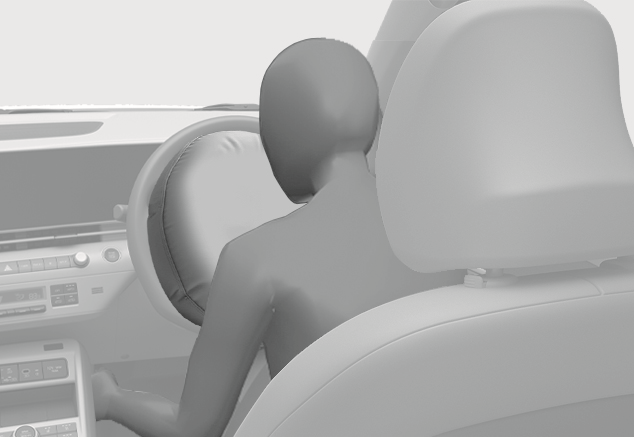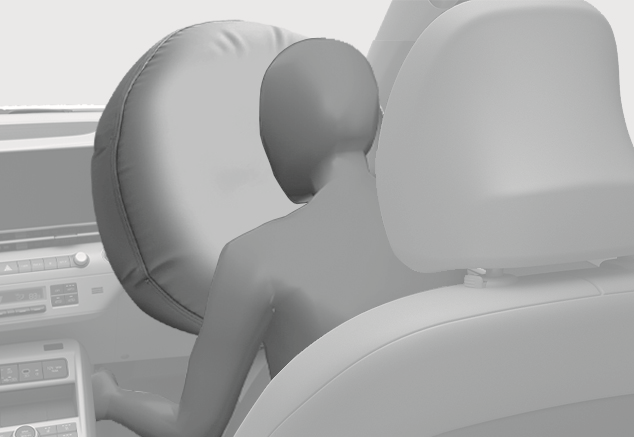How does the airbags system operate?
The SRSCM (Supplemental Restraint System Control Module) continually monitors all SRS components whilst the Engine Start/Stop button is ON to determine if a collision impact is severe enough to require airbag deployment or pretensioner seat belt deployment.
During a moderate to severe frontal collision, sensors will detect the vehicle’s rapid deceleration. If the rate of deceleration is high enough, the control unit will inflate the front airbags, at the time and with the force needed.
The front airbags help protect the driver and front passenger by responding to frontal impacts in which seat belts alone cannot provide adequate restraint. When needed, the side airbags help provide protection in the event of a side impact or rollover by supporting the side upper body area.
-
Airbags are activated (able to inflate if necessary) only when the Engine Start/Stop button is in the ON or START position, and it can be activated within about 3 minutes after the engine is turned off.
-
Airbags inflate in the event of certain frontal or side collisions to help protect the occupants from serious physical injury.
-
There is no single speed at which the airbags will inflate. Generally, airbags are designed to inflate based upon the severity of a collision and its direction. These two factors determine whether the sensors produce an electronic deployment/inflation signal.
-
The front airbags will completely inflate and deflate in an instant. It is virtually impossible for you to see the airbags inflate during an accident. It is much more likely that you will simply see the deflated airbags hanging out of their storage compartments after the collision.
-
In addition to inflating in serious side collisions, vehicles equipped with a rollover sensor, side and curtain airbags will inflate if the sensing system detects a rollover.
When a rollover is detected, curtain airbags will remain inflated longer to help provide protection from ejection, especially when used in conjunction with the seat belts.
-
To help provide protection, the airbags must inflate rapidly. The speed of airbag inflation is a consequence of extremely short time in which to inflate the airbag between the occupant and the vehicle structures before the occupant impacts those structures. This speed of inflation reduces the risk of serious or life-threatening injuries and is thus a necessary part of airbag design.
However, the rapid airbag inflation can also cause injuries which can include facial abrasions, bruises and broken bones because the inflation speed also causes the airbags to expand with a great deal of force.
-
There are even circumstances under which contact with the airbag can cause fatal injuries, especially if the occupant is positioned excessively close to the airbag.
You can take steps to reduce the risk of being injured by an inflating airbag. The greatest risk is sitting too close to the airbag. An airbag needs about 25 cm of space to inflate. It is recommended that drivers sit as far as possible between the centre of the steering wheel and the chest whilst still maintaining control of the vehicle.
To reduce the risk of serious injury or death from an inflating airbag, take the following precautions:
-
NEVER place a Child Restraint System in the front passenger seat.
Always properly restrain children under age 13 in the rear seats of the vehicle.
-
Adjust the front passenger’s and driver's seats as far to the rear as possible whilst allowing you to maintain full control of the vehicle.
-
Hold the steering wheel with hands at the 9 o'clock and 3 o'clock positions.
-
Never place anything or anyone between the airbag and the seat occupant.
-
Do not allow the front passenger to place their feet or legs on the instrument panel.

2C_DriverAirbagProcedure
When the SRSCM detects a sufficiently severe impact to the front of the vehicle, it will automatically deploy the front airbags.

2C_DriverAirbagProcedure_2
Upon deployment, a tear seam in the pad cover separates from the expansion of the airbags.
A fully inflated airbag, in combination with a properly worn seat belt, slows the driver’s or the front passenger’s forward motion, reducing the risk of head and chest injury.

2C_DriverAirbagDeployment

2C_PassengerAirbagDeployment
After complete inflation, the airbag immediately starts deflating, enabling the driver to maintain forward visibility and the ability to steer or operate other controls.
To prevent objects from becoming dangerous projectiles when the passenger’s airbag inflates:
-
Do not install or place any objects (drink holder, CD holder, stickers, etc.) on the front passenger’s panel above the glove box where the passenger’s airbag is located.
-
Do not install a container of liquid air freshener near the instrument cluster or on the instrument panel surface.